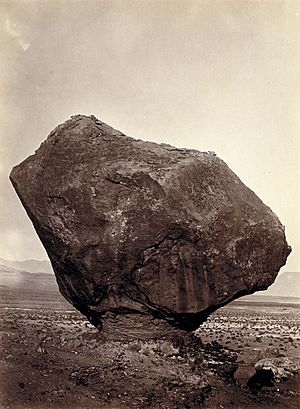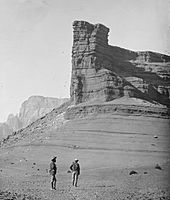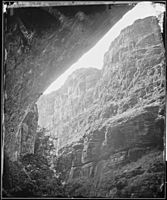William Bell (photographer) facts for kids
Quick facts for kids
William H. Bell
|
|
|---|---|
 |
|
| Born | 1830 |
| Died | January 28, 1910 (aged 79–80) Philadelphia, Pennsylvania, U.S.
|
| Relatives | William H. Rau (son-in-law) |
William H. Bell (1830 – January 28, 1910) was an amazing photographer from the 1800s. He was born in England but became famous in America. William Bell took many pictures of soldiers and their injuries during the Civil War. These photos helped doctors learn more about medicine. He also took stunning pictures of the American West as part of a big exploration trip called the Wheeler expedition in 1872. Later in his life, he wrote articles about new ways to take photos.
Contents
William H. Bell's Early Life
William Bell was born in Liverpool, England, in 1830. When he was a small child, his family moved to the United States. Sadly, his parents passed away during a cholera sickness. A kind Quaker family in Abington, Pennsylvania, near Philadelphia, raised him.
Becoming a Photographer
In 1846, when the Mexican–American War started, William Bell traveled to Louisiana. He joined the army there. After the war ended in 1848, he went back to Philadelphia. He started working in a photography studio with his brother-in-law, John Keenan.
In 1852, William Bell opened his own photography studio. It was on Chestnut Street in Philadelphia. He worked in or helped manage studios in the city for most of his life. When the Civil War began in 1862, Bell joined the First Regiment, Pennsylvania Volunteers. He fought in important battles like Antietam and Gettysburg.
Photography After the War
After the war, Bell became the main photographer for the Army Medical Museum. This museum is now called the National Museum of Health and Medicine. In 1865, he took many pictures of soldiers. These photos showed their injuries, diseases, and how they recovered. Many of these pictures were put into a medical book. He also photographed important visitors and Civil War battlefields. In 1867, he returned to Philadelphia and bought another photography studio.
Exploring the American West
In 1872, William Bell joined a big exploration trip. It was called George Wheeler's survey expedition. Their job was to map and photograph lands in the western United States. Bell took amazing large photos and 3D-like pictures (called stereographic photos). These showed parts of Utah and Arizona that few people had seen. On this trip, he tried out a new way of photography called the dry plate process. He later became an expert in this method.
After the expedition, Bell went back to his studio in Philadelphia. He showed his photos at the 1876 Centennial Exposition, a big fair in the city. Later, he sold his studio to his son-in-law, William H. Rau. In 1882, the U.S. Navy hired Bell. He was a photographer for their trip to see the Transit of Venus. This is when Venus passes in front of the Sun. On his way to Patagonia, where they watched the event, Bell took photos of the Rio de Janeiro Botanical Garden in Brazil.
In his later years, Bell mostly worked in his studio. He also wrote articles about photography techniques for magazines. In 1892, he traveled to Europe to photograph paintings for a big fair called the Columbia World's Fair.
William H. Bell's Photography Work
William Bell worked with almost every type of photography method from his time. This included early types like daguerreotypes and albumen prints. He was a leader in using the dry plate process and lantern slides. He even tried taking pictures at night using magnesium wire for light! He wrote about how to make photo chemicals and improve picture quality.
For his photos on the Wheeler Survey, Bell used two different cameras. One was for large pictures, and another for smaller 3D-like photos. He used both wet and dry methods for his pictures. His photos often show dark areas in the front, with things looking lighter further away. He photographed famous places like the Grand Canyon, the Marble Canyon, and Mount Nebo.
Bell's work was shown at big events in Vienna and Louisville in 1873. It was also at the Centennial Exposition in 1876. Today, his photographs are kept in important places. These include the Smithsonian American Art Museum and the Library of Congress.
William H. Bell's Later Life and Death
William H. Bell passed away at his home in Philadelphia on January 28, 1910. He had been sick for a long time. His son-in-law, William Rau, was also a photographer. Bell's son, Sargent, and daughter, Louisa, also loved photography. His son, Henry, worked as an engraver.
Gallery
-
Chocolate Butte near the Paria River, Arizona
-
Kanab Canyon in Arizona







